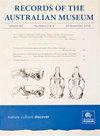1885年澳大拉西亚地理学会远征新几内亚所收集的哺乳动物注释
IF 0.8
4区 生物学
Q4 ZOOLOGY
引用次数: 0
摘要
1885年,澳大利亚地理学会派出了Bonito号蒸汽船去绘制Fly河和Strickland河(现在在巴布亚新几内亚的西部省)的地图。探险队在新几内亚呆了五个月,主要目的是进行调查和生物探索。根据探险队的原始地图和收集者w.w. Froggatt未发表的日记回忆,1937年,从探险队获得的单一标本中描述的murid啮齿动物Melomys muscalis froggatti Troughton的类型位置定位于Strickland River Observation Bend的大本营区域。对那次探险中获得的哺乳动物标本的回顾以前没有报道过,可能是由于保存下来的文献很少。探险队回到悉尼几个月后,澳大利亚博物馆馆长e·p·拉姆齐准备了一份清单,列出了博物馆收到的22种哺乳动物标本。有20个属于远征队的标本直到1913年才被录入收藏登记册,其中一半可能与远征队错误地联系在一起。大多数标本登记的收集日期和地点数据非常有限。在拉姆齐最初收到的22个标本中,有8个啮齿动物和2个狐蝠(翼狐属)没有在收集中找到,但由于没有数据,可能仍未被识别为标本。有可能在考察结束时,澳大利亚地理学会将更多的哺乳动物标本送到了其他机构。本文章由计算机程序翻译,如有差异,请以英文原文为准。
Notes on mammals collected on the 1885 Geographical Society of Australasia’s Expedition to New Guinea
In 1885 the Geographical Society of Australasia sent the steam launch Bonito to chart the Fly and Strickland Rivers (now in Western Province, Papua New Guinea). The Expedition spent five months in New Guinea with the primary objectives of survey and biological exploration. The type locality of the murid rodent Melomys muscalis froggatti Troughton, 1937, described from a single specimen obtained during the Expedition, is localized to the region of the base camp at Observation Bend, Strickland River, based on the original Expedition maps and the unpublished diary reminiscence of the collector W. W. Froggatt. A review of the mammal collection obtained during that Expedition has not been reported previously, perhaps due to the poor surviving documentation. Several months after the Expedition returned to Sydney, Australian Museum curator E. P. Ramsay prepared a list of 22 mammal specimens received by the Museum. Twenty specimens attributed to the Expedition were not entered into the collection registers until 1913, half of which are likely to be incorrectly associated with the Expedition. Most specimens were registered with very limited data about collection date and locality. Of the 22 specimens originally received by Ramsay, eight rodents and two flying foxes (Pteropus spp.) have not been located in the Collection, but might remain unrecognized as specimens with no data. It is possible that additional mammal specimens were sent by the Geographical Society of Australasia to other institutions at the conclusion of the Expedition.
求助全文
通过发布文献求助,成功后即可免费获取论文全文。
去求助
来源期刊
CiteScore
0.90
自引率
0.00%
发文量
9
审稿时长
>12 weeks
期刊介绍:
Records of the Australian Museum, volume 62 was published in 2010, volume 63 in 2011. Monographic works of particular significance are published irregularly as Records of the Australian Museum, Supplements (ISSN 0812-7387).

 求助内容:
求助内容: 应助结果提醒方式:
应助结果提醒方式:


